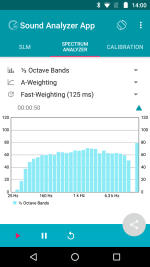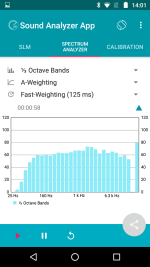We (all da major UK speaker makers) used both Elcap & Alcap and considered them much the same.
They DO make much better caps with low ESR but only to special order. The physical size is a good indication of whether they were 'low loss' so Steve's 4u7 is probably a good un.
Whether the sound changes a lot depends on the exact xover & speaker. I'd expect Delta 30 to sound slightly brighter but not to an objectionable extent. Not so sure about Glendale XP2.
A less well known aural artifact is the cheaper electrolytics' ESR change with level.
I first saw (heard) this with the original KEF 104 which used really yucky caps. I swapped these for films and twiddled the xover so the speaker sounded the 'same'. But when the level rose, the 'original' would tend to sound less bright compared to the version with films.
KEF 104ab used much bigger Elcaps and didn't have this 'feature'.
BTW, this illustrates an important point about making changes. Tweak only ONE of a pair at the time to see if there is a worthwhile improvement before tweaking the other to suit.
They DO make much better caps with low ESR but only to special order. The physical size is a good indication of whether they were 'low loss' so Steve's 4u7 is probably a good un.
Whether the sound changes a lot depends on the exact xover & speaker. I'd expect Delta 30 to sound slightly brighter but not to an objectionable extent. Not so sure about Glendale XP2.
A less well known aural artifact is the cheaper electrolytics' ESR change with level.
I first saw (heard) this with the original KEF 104 which used really yucky caps. I swapped these for films and twiddled the xover so the speaker sounded the 'same'. But when the level rose, the 'original' would tend to sound less bright compared to the version with films.
KEF 104ab used much bigger Elcaps and didn't have this 'feature'.
BTW, this illustrates an important point about making changes. Tweak only ONE of a pair at the time to see if there is a worthwhile improvement before tweaking the other to suit.
Last edited:
Could you post pics of the 2 measurements please? Please humour an old speaker hack relive past glories 😉The discontinuity in the chirp on the Delta 30s was on the stream from the Roberts Radio as it happened again on the Glendale XP2 testing - this time I spotted it on the radio display.
A less well known aural artifact is the cheaper electrolytics' ESR change with level.
I'll admit to going the whole hog by replacing all the ELCAPs in my friend's E50 crossovers with polypropylene capacitors.
All, that is, apart from the 50 uF bass capacitors that I replaced with fresh 47 uF electrolytics.
I was involved in the design of E50 too and my guess nearly 50 yrs later is that this would be an improvementI'll admit to going the whole hog by replacing all the ELCAPs in my friend's E50 crossovers with polypropylene capacitors.
All, that is, apart from the 50 uF bass capacitors that I replaced with fresh 47 uF electrolytics.
Not sure what I can post in this case. I'm using a Roberts iStream83 initially as a DAB radio and latterly as Internet Radio (much more reliable). The chirp was being streamed from my PC so reliant on a wi-fi link. Any discontinuity has been nearer the start of the 'chirp' almost certainly due to buffering.Could you post pics of the 2 measurements please? Please humour an old speaker hack relive past glories 😉
ClassicFM plays well on 'Internet Radio' via the Roberts, and a bit of research suggests it should have a higher bit rate than DAB. We had moved the TV and hi-fi due to taking on mothercare, and the DAB signal in the new corner was much weaker than it had been in the old corner where it had been more reliable than the amplified FM signal from a loft arial. We are in a deep narrow valley and don't have line of sight to the Mendip transmitter just 6 miles away, so use the Blackdown transmitter that we do have a line of sight to - though this is somewhat theoretical due to distance.
In testing my speakers (on topic again), is it reasonable to consider my Roberts iStream83i a reasonable quality audio source? Is the frequency analyser app (to 1/3 octave) on my Motorola G3 smartphone likely to be accurate/useful? The G3 is my goto 'Android App' device, as I have a tough little Motorola Defy+ as my phone/camera/calendar/clock/torch - a brilliant device that never could do 'internet' fast enough. The G3 being on an older version of Android limits what is available to me in Google Play, but useful Andoid App suggestions welcomed.
For anyone interested, an Alcapped Crossover for a Glendale XP2. I did one cap at a time, the markings on the 33uF capacitors were very faint, but I could read them so was able to confirm correct values for each one as I put them in. I used a suction solder remover to help free the old Elcaps from the big blobs of authentic 1970s solder.
You said the Glendale looked to have smoother response than the Delta 30 so couple of photos of your 1/3 8ve Frequency Analyser display would qualify what you said.Not sure what I can post in this case.
Did you use the app for the chirps too?
You said the Glendale looked to have smoother response than the Delta 30 so couple of photos of your 1/3 8ve Frequency Analyser display would qualify what you said.
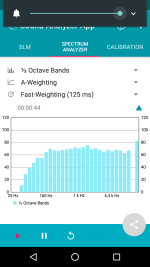
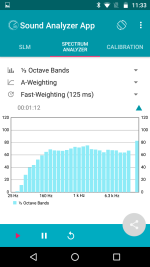
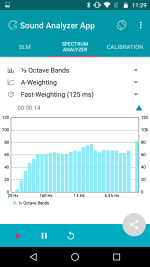

The G3 not very responsive to snapshotting via the power + down_vol buttons (every day a school day), so these are genuinely random samples. Pink noise on a single speaker with same volume setting. The Glendales (right) look to have a fraction more bass and a little peak from 1 to 2khz that is smoother on the Deltas (left). My observation that the Deltas need less volume not evident here. I would have thought that the Delta 30s come out of this pretty well - they will be an asset when relocated to my hobby room.
Unfortunately that peak from 1 to 2khz is well over 10dB and appears to be creating a harshness that I initially thought was liveliness. It seems to affect strings and piano, but it's likely to be a problem for human voice as well. I didn't notice that harshness before, and I'm wondering which driver it's likely to be, and which of the Alcaps to revert first to see if the Elcaps were doing it too.and a little peak from 1 to 2khz
The crossover points are 1.3 kHz and 4.5 kHz so the problem is likely to lie with the mid driver.
The 4.7 uF will be associated with the tweeter high pass filter and the 32 uF with the woofer low pass filter.
This means that the two 10 uF capacitors must be associated with the mid driver band pass filter.
P.S. It would be worth checking that all drivers have been connected with the correct electrical polarity. Both the mid and the tweeter are likely intended to be of reverse electrical polarity to the woofer, i.e., the mid and treble negative terminal go to the positive speaker input terminal whereas the woofer positive terminal goes to the positive speaker input terminal.
The 4.7 uF will be associated with the tweeter high pass filter and the 32 uF with the woofer low pass filter.
This means that the two 10 uF capacitors must be associated with the mid driver band pass filter.
P.S. It would be worth checking that all drivers have been connected with the correct electrical polarity. Both the mid and the tweeter are likely intended to be of reverse electrical polarity to the woofer, i.e., the mid and treble negative terminal go to the positive speaker input terminal whereas the woofer positive terminal goes to the positive speaker input terminal.
Look at the '2nd order 3-way' crossover schematic below that will show the basic layout of your Glendale XP2 crossover circuit.

I note the speaker specs say "crossover rates 6 dB and 12 dB per octave".
It is possible that the mid driver filter is 6 dB per octave, meaning that it comprises only of one capacitor in series with one inductor.
Or perhaps the bass filter consists only of a series inductor.
I also see extra components on the crossover board, such as the little tubular inductor at bottom right, that are likely to do with response shaping.
If we find we need to dig deeper into the crossover layout, it would help if you should list the capacitor values, starting top left on your photo of the board and moving clockwise to bottom right.
In addition, if it is possible to read the mH values written on all four white inductor wrappings please list them clockwise from top left.
It is possible that the mid driver filter is 6 dB per octave, meaning that it comprises only of one capacitor in series with one inductor.
Or perhaps the bass filter consists only of a series inductor.
I also see extra components on the crossover board, such as the little tubular inductor at bottom right, that are likely to do with response shaping.
If we find we need to dig deeper into the crossover layout, it would help if you should list the capacitor values, starting top left on your photo of the board and moving clockwise to bottom right.
In addition, if it is possible to read the mH values written on all four white inductor wrappings please list them clockwise from top left.
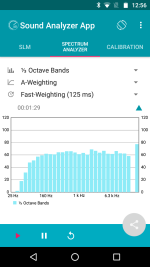
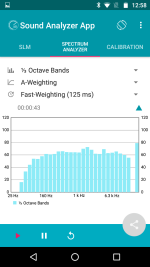
It suddenly occured to me that I hadn't run the spectrum analyser on the right speaker - happily that looks (and sounds) OK. It was always unlikely that the recapping was wrong in principle, and this would confirm it. I'll check the drivers are connected correctly and if that's OK remove the crossover and have a look for a dry joint.
Edit: A very obvious dry joint found and fixed on one of the 10uF caps!
Last edited:
Edit: A very obvious dry joint found and fixed on one of the 10uF caps!
Geez, I must contain my excitement when it come to analysing crossover networks!
As you get older you need to get your excitement where you can! Still a most interesting insight into what might have be going on, and you were able to very pinpoint that the 10uF caps might have/be a problem.Geez, I must contain my excitement when it come to analysing crossover networks!
I just wish I'd looked at the output from the other one first, instead of assuming the problem must affect both - lesson learnt!
Yeah, it did cross my mind to ask if the problem was occurring in both speakers, but I hesitated to insult your intelligence! 
I hope you're enjoying the "gentle, warm sound" of the Glendale XP2 and the "tuneful, bouncing bass" of its sealed enclosure - as mentioned in this review:
https://vintagesonics.com/reviews/loudspeakers/wharfedale-xp-series-review/
Quote: "The XP2 series was replaced by the new Laser series, with the high end eventually going to the TSR (Total Sound Recall) range, which gave birth to the Wharfedale Diamond a few years later."
A pair of Glendale XP2s cost £105 back in 1978, equivalent to £588 now according to the Bank of England inflation calculator.

I hope you're enjoying the "gentle, warm sound" of the Glendale XP2 and the "tuneful, bouncing bass" of its sealed enclosure - as mentioned in this review:
https://vintagesonics.com/reviews/loudspeakers/wharfedale-xp-series-review/
Quote: "The XP2 series was replaced by the new Laser series, with the high end eventually going to the TSR (Total Sound Recall) range, which gave birth to the Wharfedale Diamond a few years later."
A pair of Glendale XP2s cost £105 back in 1978, equivalent to £588 now according to the Bank of England inflation calculator.
Why d
What puzzles me is that the speakers sound as they should using my humble Roberts iStream83 as an internet radio receiver, but a tad harsh from my Sony CDP-FE270 CD player. I don't believe that decent hi-fi needs bass and treble controls. and indeed reducing the treble doesn't seem to help.
It wasn't there to be insulted - 'smarts' have a nasty habit of going missing when you need them... Not a Ford guy, so really not sure about the wisdom of expecting much from the Ford Consul (Granada) of speakers!but I hesitated to insult your intelligence!
What puzzles me is that the speakers sound as they should using my humble Roberts iStream83 as an internet radio receiver, but a tad harsh from my Sony CDP-FE270 CD player. I don't believe that decent hi-fi needs bass and treble controls. and indeed reducing the treble doesn't seem to help.
The Glendale XP2 midrange drivers operate between 1.3 kHz and 4.5 kHz where human hearing is extremely sensitive. Too much boosting around these frequencies can cause listening fatigue.
Perhaps the CD delivers more energy at those frequencies than the internet radio, and using the treble control doesn't sufficiently reduce their level.

That's simply a hypothesis. It may be missing some "smarts"!
Perhaps the CD delivers more energy at those frequencies than the internet radio, and using the treble control doesn't sufficiently reduce their level.
That's simply a hypothesis. It may be missing some "smarts"!
- Home
- Loudspeakers
- Multi-Way
- Wharfedale Glendale XP2 recapping
